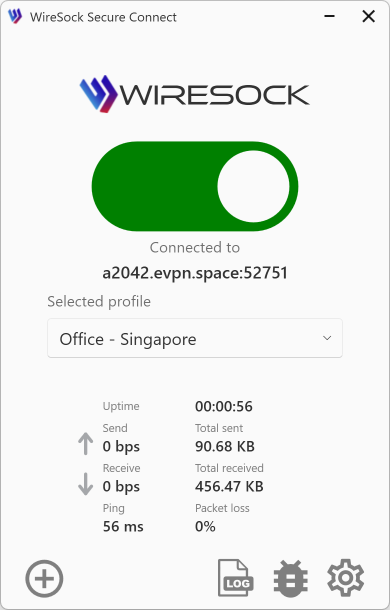Understanding WireSock Virtual Adapter Mode and Transparent Mode
WireSock Secure Connect offers two operational modes: Virtual Adapter Mode and Transparent Mode, each designed to cater to different use cases and network configurations. Understanding their differences can help users choose the most suitable mode for their needs.
WireSock Virtual Adapter Mode
Overview
Virtual Adapter Mode creates a dedicated virtual network interface for handling VPN traffic. By modifying system-wide routing tables, WireSock directs traffic through this adapter, intercepts it, and encapsulates it within a WireGuard tunnel, providing enhanced control and flexibility. However, it requires elevated privileges to create and manage the virtual adapter.
Key Features
- Dedicated Virtual Interface
- A separate network adapter is created to manage VPN traffic independently of the system’s default network interface.
- Enhanced Compatibility
- Works well with applications that expect a standard network interface.
- Improved Stability & Security
- Isolates VPN traffic, minimizing interference with other network connections.
- Helps obscure VPN usage by integrating it into the system as a standard network adapter.
- Selective Traffic Routing
- Allows better control over which traffic is routed through the VPN.
- Useful for split tunneling and policy-based routing.
Use Cases
- When a dedicated virtual adapter is needed for better application compatibility.
- If Transparent Mode causes conflicts with certain network configurations.
- For scenarios requiring a separate VPN interface.
WireSock Transparent Mode
Overview
Transparent Mode does not require a virtual network adapter. Instead, it intercepts and redirect traffics at the packet level, making VPN integration seamless and lightweight. Transparent Mode operates with lower system impact and does not require administrative access. This is the default operational mode.
Key Features
- No Virtual Adapter Required
- Operates entirely in the background without creating an additional network interface.
- Minimal System Modification
- Avoids changes to global routing tables, reducing potential conflicts with existing network settings.
- Stealthy & Efficient
- Lower resource usage compared to Virtual Adapter Mode.
- Selective Traffic Routing
- Uses packet level to intercept and forward only selected traffic through the VPN.
- Enables split tunneling and application-specific routing.
Use cases
- When a lightweight and high-performance VPN mode is needed.
- If system-wide routing modifications are not desirable.
Comparison: Virtual Adapter Mode vs. Transparent Mode
| Feature | Virtual Adapter Mode | Transparent Mode |
|---|---|---|
| Uses Virtual Adapter | ✅ Yes | ❌ No |
| Traffic Isolation | ✅ High | ✅ High |
| Application Compatibility | ✅ Better | ⚠️ May interfere with some apps |
| System-wide Routing Changes | ✅ Yes | ❌ No |
| Stealth & Performance | ✅ High | ✅ High |

